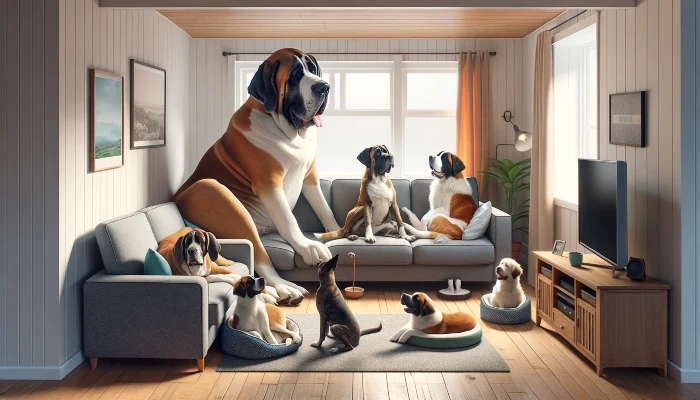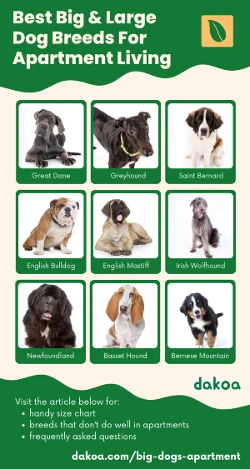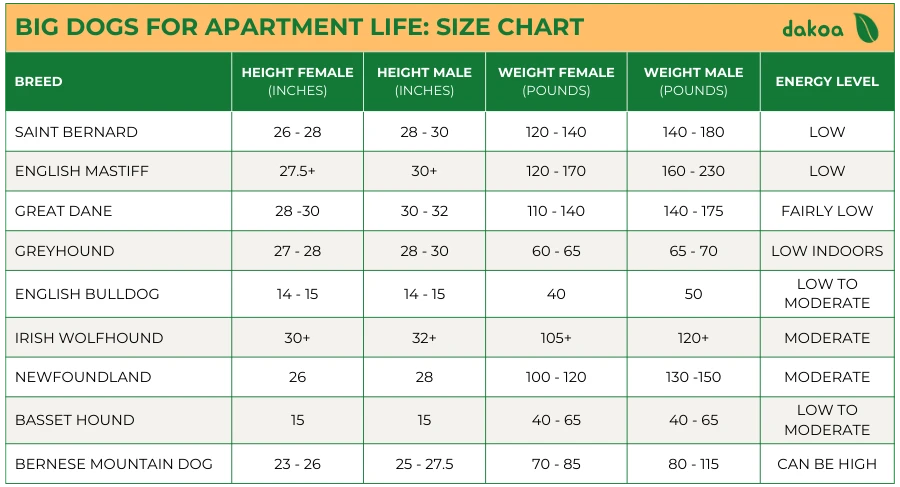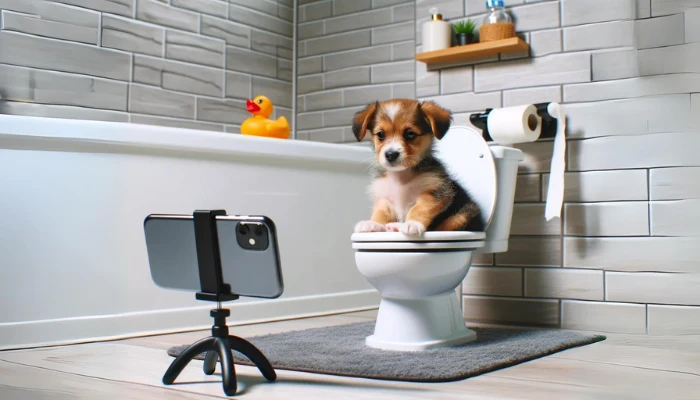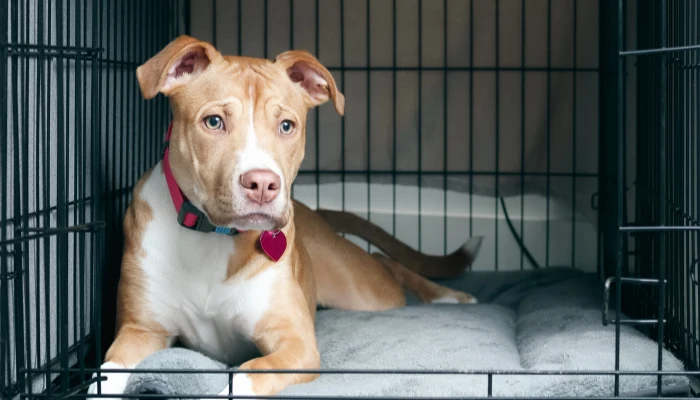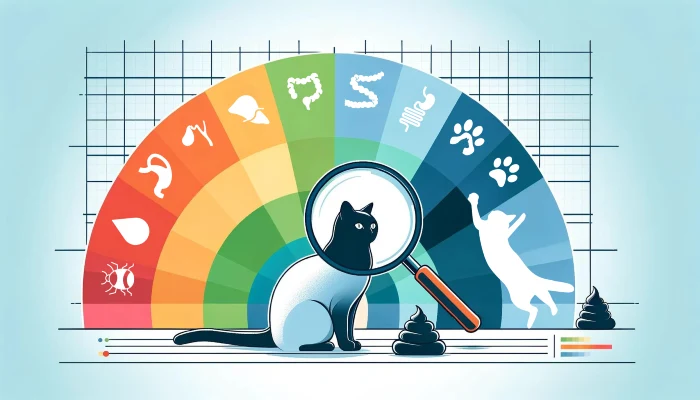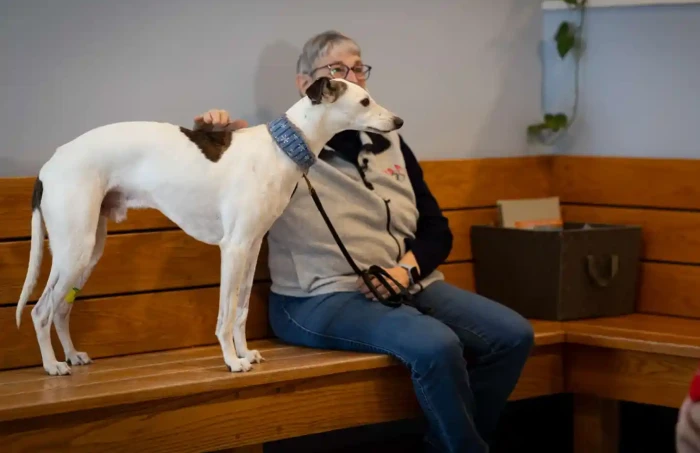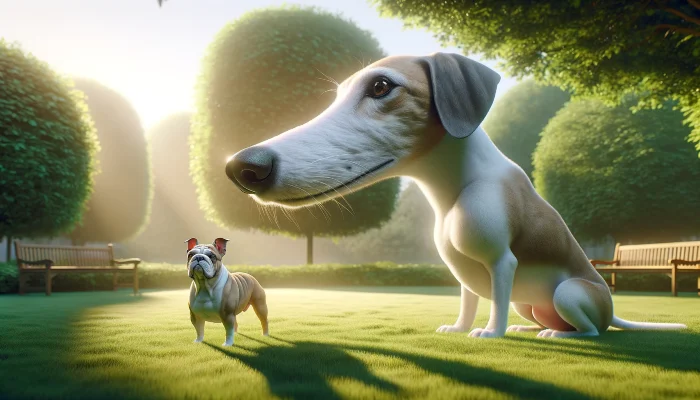Think big dogs can’t handle apartment life? Think again! Gentle giants like Great Danes, Bernese Mountain Dogs, and Saint Bernards often make amazing apartment pets. While they need daily walks and trips to the dog park, they bring so much love and joy in return.
If you dream of having a large breed best friend but worry about a small space, don’t let size fool you – with the right care, a big dog can be your perfect apartment buddy. Experienced apartment dwellers and experts at the American Kennel Club agree it’s not always about square footage!
Key Takeaways:
- Great Danes, Bernese Mountain Dogs, and Saint Bernards can be great apartment dogs.
- Big dogs do need exercise, but they’re often surprisingly adaptable to smaller spaces.
Why Consider a Large Dog for Your Apartment?
Forget the idea that apartments are only for small dogs! Big breeds like Golden Retrievers, Afghan Hounds, or even Standard Poodles can be amazing apartment buddies. They’re incredibly loyal and loving, and honestly, who wouldn’t feel safer with a gentle giant around? Even energetic large breeds can thrive in city life with appropriate training and exercise.
It’s a myth that big dogs are always bouncing off the walls. Many are super chill and happy to relax with you inside after a trip to the dog park. If you walk them regularly and keep their minds active, they can thrive even in smaller spaces. This opens up so many more options for apartment dwellers – it’s a win for everyone!
Key Factors to Consider When Choosing a Large Dog for Apartment Living
Not all big dogs are created equal! When selecting your furry apartment companion, here’s what to focus on:
- Energy levels: Does the dog thrive with all-day activity, or would they rather lounge with you? Lower-energy breeds like English Mastiffs and Cavalier King Charles Spaniels often adapt better to apartments.
- Personality: Pick a dog with a gentle, easygoing nature. They’ll get along better with neighbors in close quarters, especially in apartment buildings.
- Size (within reason): Sometimes a slightly smaller “large breed” will handle apartment life more easily. Consider options like Clumber Spaniels or French Bulldogs.
- Your building & neighbors: Do you have breed restrictions, weight limits, or size limits? Are your neighbors comfortable with big dogs? Discuss this with apartment managers before you fall in love.
- Outdoor space: Can you easily reach a park or other open areas for walks, playtime, and mental stimulation? A dog with lots of exercise is key to successful city life.
Good choices for apartments often include low to moderate energy breeds like Saint Bernards, Newfoundlands, and English Mastiffs. They offer lots of love without taking up too much room – though keep in mind, big pups mean big messes, so be prepared!
Understanding Your Dog's Needs: Exercise, Playtime, and Space
You might be surprised – big dogs, even gentle breeds like Saint Bernards, English Mastiffs, and Great Danes, don’t always need a huge backyard to be happy. Of course, even low-energy dogs require regular exercise. Daily walks are a must! A quick trip around the block or a visit to the dog park gives your big buddy that essential opportunity to burn energy, explore, and stay mentally happy.
If you don’t have ample space inside, get creative! Indoor games like hide-and-seek, fetch in a long hallway, and using puzzle toys keep your dog’s mind busy while getting a physical workout.
Apartment living with a big dog means getting creative with space planning. Make the most of what you have! Create a cozy dog nook with their favorite bed and toys, or dedicate a play area where you practice training. A bit of furniture rearranging and smart planning can easily make room for playtime, training, and lots of cuddles. With love and commitment, you and your large breed pup can enjoy apartment life together!
Top Picks: The Best Big & Large Dog Breeds for Apartments
Ready to bring a big furry friend into your apartment? You’re in luck! Many dog breeds handle smaller spaces surprisingly well, though a little extra training and exercise might be required for apartment living. Their gentle, loving nature makes them perfect companions, just be sure to check if there are breed or size restrictions where you live before making a commitment.
It’s not all about size with good apartment dogs. A great apartment dog also needs the right personality and a moderate energy level. That’s why this list will help you find the perfect match. Be sure to meet individual dogs, as even smaller breeds can occasionally have energy levels that don’t mesh well with a smaller space. Let’s get started!
Important Note: Individual dogs matter! Not every dog, even those labeled ‘apartment-friendly’, will be the perfect fit for everyone. Get to know your potential pup at a shelter or with a reputable breeder to make sure they’re the right choice for you!
Saint Bernard: The Gentle Giant
Don’t let size fool you – Saint Bernards are big softies! Often referred to as gentle giants, their laid-back personalities make them surprisingly low maintenance even in a small apartment. These lovable pups need daily walks and some playtime, but they’re happiest curled up on the couch with their people.
Saint Bernards are famously gentle and patient, which is perfect for apartment life where neighbors are closer. If you’re looking for a loyal, easygoing companion with a love for cuddles (and maybe a bit of drool!), a Saint Bernard could be your perfect match. Due to their thick coats, they do require regular brushing to keep their coats healthy and shedding under control.
Bernese Mountain Dog: The Gentle Companion
With their striking tri-color fur and kind eyes, Bernese Mountain Dogs radiate gentleness and affection. Although large and often high-energy, they are generally calm indoors and content to relax after a good walk or playtime. Just like Saint Bernards, Bernese Mountain Dogs do require regular grooming due to their longer coat.
English Mastiff: Quiet and Companionable
Don’t let their towering stature intimidate you! English Mastiffs are surprisingly well-suited for apartments, thanks to their low-energy personalities. They’re the ultimate couch potatoes, happy to snooze the day away by your side. Daily walks are a must for health and well-being, but they tend to adjust to limited indoor space better than energetic breeds. With their gentle nature and eagerness to please, English Mastiffs make loyal and loving companions, though be prepared for some drool as part of their charm! I would recommend strategically placing dish towels around the apartment to keep your clothes and furniture drool free.
Great Dane: Elegance in a Large Package
Great Danes are gentle giants that adapt surprisingly well to apartment living. They’re graceful indoors, navigating smaller spaces with ease. Sure, they need regular exercise like any dog, but they prefer a good walk, some playtime at the park, and then lots of cuddles on the sofa. Great Danes make affectionate and playful companions, though with any large breed, early training is crucial.
Greyhound: The Retired Racer
Known for their incredible speed on the track, these gentle souls adapt surprisingly well to city life. While they need space to stretch their legs, Greyhounds make amazing apartment dogs once their racing days are over. Enjoy daily walks with the occasional zoomies session at the park to keep them happy and content.
Irish Wolfhound: The Dignified Companion
These majestic giants hold themselves with calm dignity. Often seen as intimidating due to their imposing size, Irish Wolfhounds are actually gentle and affectionate family dogs. Despite their height, they tend to be less rambunctious than you might expect and require moderate exercise for a large breed. Remember, they’ll need an understanding landlord – and elevator! – since size alone can worry others.
Basset Hound: The Mellow Maestro
With their droopy eyes and long ears, Basset Hounds are a classic choice for laid-back apartment living. Their mellow personality and moderate energy levels mean shorter daily walks are often enough. Keep in mind, Basset Hounds have a booming bark and love to follow their noses, so early obedience training and frequent check-ins during walks are recommended!
Bulldog: The Ultimate Couch Potato
Famous for their wrinkly faces and love of lounging, Bulldogs make some of the best large breed apartment dogs. While they have short bursts of playful energy, Bulldogs are happy to chill with their favorite humans, a trait perfectly suited to smaller spaces. Bulldogs generally handle city life well with a few considerations Remember, Bulldogs might struggle more in hot weather, so air conditioning is essential for your pup’s comfort.
Newfoundland
The Gentle Giant Newfoundlands, or Newfies, are fluffy titans known for their sweet and patient nature. Possessing surprisingly moderate energy for their size, Newfies happily relax beside you in your apartment after a good walk or playful swim. Be prepared for some shedding – Newfies have a thick, double coat that does require regular grooming. They thrive on companionship and plenty of fresh water!
Things To Keep In Mind
- Individual Dog Matters: No matter the breed, it’s essential to get to know the individual dog you’re considering. Not every dog, even those from ‘apartment-friendly’ breeds, will take effortlessly to smaller spaces.
- Breed Restrictions & Rules: Always investigate potential breed or size restrictions before bringing home a large dog. Check with your apartment complex policies as well as city and HOA ordinances. It’s disappointing to fall in love with a pup only to realize they’re not allowed within your community.
- Exercise & Mental Stimulation: Just because you have a smaller space doesn’t mean your big dog will skip exercise! Here’s how to keep them feeling their best:
- Daily walks are non-negotiable! A jaunt around the neighborhood or dog park fun gives a physical and mental outlet
- Puzzle toys to the rescue! These keep your dog’s brain working even without loads of extra space.
- Indoor playtime or training: A happy dog is a tired dog! Get creative – fetch, chase, hide-and-seek… any games that encourage movement are fantastic. Remember, a large dog still needs space to stretch out sometimes!
- The Right Mix: Combine exercise and downtime to build a strong bond and manage energy levels. A well-stimulated pup makes the best apartment neighbor!
Adapting to Apartment Life: Training and Socialization Tips
A well-trained and socialized big dog makes the best apartment neighbor, regardless of your square footage! By making training a priority, you and your furry friend can flourish in city life. Here’s how you and your furry pal can make apartment life smooth for everyone:
Training is key: Teach your dog essential commands like sit, stay, “quiet”, and focus on excellent leash manners. This makes life manageable in smaller spaces and busy common areas. Check into a local obedience school and take your big pup through at least a basic obedience course.
Beat barking boredom: A tired, mentally engaged dog is less likely to bark excessively. Puzzle toys, walks, playtime, and structured training sessions are your dog’s best defense against those noisy zoomies!
Respecting your neighbors: Teach your dog to sit calmly in the elevator and give others in apartment hallways appropriate space. If your dog needs extra room, or you live in tight quarters, try traveling during less busy times and give clear indications if you need some distance.
Socialization is important: Parks, dog-friendly businesses, and training classes are excellent ways for your big pup to safely meet other dogs and people. Proper socialization creates confident dogs who adjust to city living with ease!
A little effort goes a long way: It’s all about understanding and anticipating your dog’s needs, respecting those around you, and prioritizing proper training for apartment-sized success. With consistent effort, even large breed dogs can live happily in apartment communities!
Finding the Right Fit: Size, Temperament, and Energy Levels
It’s tempting to focus on size alone when deciding if your space fits a big dog, but the best apartment dogs strike a balance. Here’s what to keep in mind:
- Rules and restrictions: Before falling in love with a large breed, check with your landlord about any breed or weight limits. Some places are surprisingly dog-friendly, accepting well-behaved pups like English Mastiffs and even Great Danes!
- It’s not all about size: A calm, relaxed Great Dane might do perfectly well in your studio apartment, while a high-energy Jack Russell Terrier or Beagle will likely feel cramped and become destructive. Similarly, a low-energy Basset Hound or Cavalier King Charles Spaniel might handle apartment living far better than a Siberian Husky or Australian Shepherd bred for working farm life.
- Lifestyle Match: Be honest about your activity level. If you enjoy lazy evenings on the couch, a laid-back Saint Bernard or Bulldog could be your match. If you’re an avid hiker, an active and athletic Standard Poodle or Vizsla might be a better choice, ensuring they get enough exercise even if your space is on the smaller side.
- The Perfect Match: When you focus on temperament and exercise needs, apartment living can be fantastic for even surprisingly large breeds! When matched with appropriate training and plenty of mental stimulation, your big furry friend will bring more joy than space concerns.
When Bigger is Better: Dispelling Myths about Large Dogs and Apartments
Forget the old mindset that apartment living requires a small dog! Plenty of lovable, gentle giants make ideal apartment pets. Breeds like Saint Bernards, English Mastiffs, and even gentle Great Danes often adjust remarkably well. In fact, they sometimes fare better than their high-energy smaller cousins, like feisty Jack Russell Terriers or Chihuahuas prone to anxiety!
Here’s the secret: It’s about your commitment to exercise and mental playtime, more than it is about square footage. Daily walks, visits to the dog park, training sessions, and brain-teaser toys give big dogs the stimulation they crave.
The myth that you need a giant house for a giant dog holds many people back from fulfilling their big dog dreams! If you choose a breed well-suited to apartment life and commit to proper care, a smaller living space with a spacious heart can be the perfect home for you and your canine companion.
Not All Breeds Thrive in Apartments
While many large breeds excel in apartments, not every dog thrives in smaller spaces. Here’s a quick overview of breeds better suited to homes with extra square footage or active lifestyles:
- Working Dogs: Breeds like Siberian Huskies, Australian Shepherds, Border Collies, and Belgian Malinois were bred for farm life, herding, and high-intensity jobs. Apartment living can lead to destructive boredom for these high-drive dogs.
- Hounds: Scent hounds like Beagles, Bloodhounds, and Foxhounds often have booming barks and strong instincts to follow scents. This creates challenging conditions within confined spaces or densely populated areas.
- High-Energy Terriers: While small, breeds like Jack Russell Terriers, Rat Terriers, and Airedale Terriers love adventure and need tons of physical and mental stimulation. Their feisty personalities might cause tension in tight quarters.
- Dogs Prone to Separation Anxiety: Some breeds, like German Shepherds, Vizslas, or Labrador Retrievers, form strong bonds. If left alone in a small space for extended periods, they’re more likely to become destructive or distressed.
Important: Even within these groups, you’ll find exceptions! Responsible breeders can help assess individual energy levels and anxiety thresholds when considering a mixed environment.
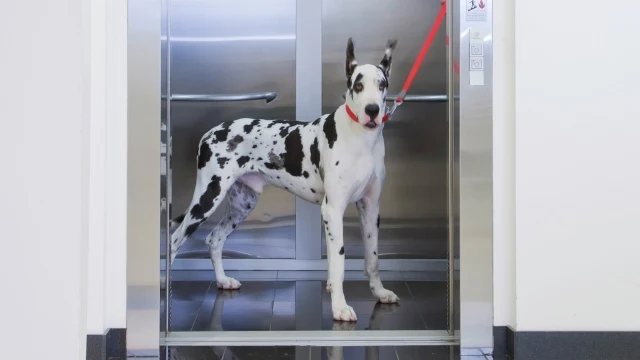
Think Your Apartment Is Too Small For a Dog? These Breeds Might Agree
While many wonderful dogs do well in apartments, some breeds struggle in tighter living spaces. Below are examples where apartment life might not be the best fit. Remember, even within breeds, there are individual variations, but here are some general guidelines:
Rhodesian Ridgeback: These powerful, athletic dogs thrive on dedicated space for running and exercising. Their independent streak makes city living challenging. Rhodesian Ridgebacks do best with outdoor-centric households and plenty of room to burn energy.
Afghan Hound: Known for their striking fur and independent nature, Afghan Hounds tend to have a high prey drive. Securely fenced yards are a must to prevent chasing small animals – in apartments, this instinct often translates to escapism. Afghans also need considerable grooming due to their long coats.
Border Collie: Bred for their incredible work ethic, Border Collies often struggle when not given constant jobs to do. An apartment’s limitations are simply frustrating for these intelligent herding dogs, creating potential for disruptive, neurotic behaviors. These pups excel in settings where they can be physically and mentally engaged for most of the day.
Siberian Husky & Alaskan Malamute: Highly vocal dogs like Huskies and Malamutes are infamous for howling and ‘talking’, potentially troubling close-quartered neighbors. Their dense, shedding coats are designed for colder climates, and they overheat easily. Both are escape artists who thrive with lots of dedicated outdoor playtime.
Clumber Spaniel: These loveable gentle giants require quite a bit of space, even indoors, due to their size and floppy nature. While gentle, they lack physical awareness around furniture and other breakable items. This could make them an accidental-destruction candidate within an apartment context.
Important Note: Consider both physical needs and breed-specific traits. High-energy pups often thrive in more compact spaces like apartments when given structured, dedicated exercise. Even gentle large breeds with low energy levels might struggle with purely physical space challenges due to their massive size. Less space-constrained breeds include smaller terriers, Italian Greyhounds, and Bichon Frises, often adapting more easily to city living thanks to their lighter frames and more moderate needs. Remember, it’s ultimately about providing adequate space and enrichment based on both the breed and its individual personality!
High-Prey Drive and Escape Artists: You've Been Warned!
Some breeds have incredibly strong instincts that can be especially challenging within apartments. High-prey drive or escape tendencies require both responsible management and consideration of your surrounding environment. These breeds might pose difficulty due to the close proximity of neighbors, busy streets, and restricted physical space found in apartment living:
Ibizan Hound, Pharaoh Hound, Basenji
Primarily sight hounds (and, for the Basenji, scent driven as well), these dogs’ reflexes are hardwired to give chase. This leads to potential escapes in pursuit of perceived prey like squirrels, birds, and other small animals. Ibizan and Pharaoh Hounds are incredibly agile and often excel at finding the one weak spot in an enclosure, a major risk within confined settings.
Other Considerations: Lineages & Genetics
Certain breeds from working and guard dog lineages can demonstrate territorial barking or protective tendencies, which might escalate due to close proximity in apartment settings. While training can provide some buffer, you can’t ignore genetic predispositions to understand risk levels within constrained living spaces.
IMPORTANT: These breeds can make loving companions in the right setting! Their challenges simply warrant extra responsibility, dedicated training, and often a physically active lifestyle with plenty of structured time outdoors in secure areas. Always research extensively or consult with an experienced breeder if considering dogs with potential for strong chase instincts or heightened territorial anxieties.

Frequently Asked Questions (FAQ)
Can big dogs really live happily in apartments?
Absolutely! Many large dog breeds excel in apartments. It’s more about their temperament, energy levels, and exercise needs than size alone. Gentle giants like Great Danes, Saint Bernards, and English Mastiffs make fantastic apartment pets. And surprisingly, many slightly smaller breeds with moderate energy levels can thrive in smaller spaces with a loving, dedicated owner. Focus more on training and regular physical playtime outside than apartment size!
What are the best large dog breeds for apartments?
Top apartment-friendly large breeds include Saint Bernards, English Mastiffs, Bulldogs, Basset Hounds, Irish Wolfhounds, Greyhounds, Newfoundlands, and, of course, Great Danes. But don’t discount other breeds – talk to breeders, shelters, and experienced dog owners about individual dogs with calm personalities and lower energy levels. Even within one breed, you’ll find variations in personality!
How do I exercise my big dog in a small apartment?
Daily walks are essential! Explore dog parks and walking trails for outdoor adventures. Mental stimulation is just as important as physical exercise – try puzzle toys, hide-and-seek, or indoor training sessions. If you have hallway space or access to stairs, utilize those for active indoor games like fetch or chase. Get creative to meet their needs – remember, a tired dog is a happy dog!
How do I deal with apartment weight limits for dogs?
-
- Research before you rent: Find buildings welcoming larger breeds or with flexible weight limits.
- Talk to your landlord: Emphasize well-behaved, gentle giants come in all sizes! Some landlords are open to making exceptions for calm, well-trained, and well-groomed pups.
- Highlight positive breed traits: Focus on your dog’s gentle nature, excellent manners, and love of lounging with you.
Are there other apartment living tips for big dog owners?
-
- Training is your best friend: Teach basic commands, good leash manners, and address barking to minimize noise-related concerns.
- Respect your neighbors: Clean up after your dog, use alternative exits if there are dog-phobic neighbors, and generally be a considerate member of your shared community.
- Be a good ambassador: A well-behaved large dog breaks down negative stereotypes for everyone! Demonstrate that calm giants make great neighbors, opening doors for future large breed dog owners living in apartments.
Are Golden Retrievers good apartment dogs?
While Golden Retrievers are loving and adaptable, they aren’t the ideal apartment breed. They possess high energy levels that thrive better with plenty of room to run and play. If apartment living is your only option, a Golden Retriever is only manageable with rigorous daily exercise and dedicated enrichment for mental stimulation. Consider researching slightly smaller retrievers like Flat-Coated Retrievers or Nova Scotia Duck Tolling Retrievers, who might be better suited to city life.
A Giant Leap for Apartment Dwellers
If you have a big furry friend (or dream of one) don’t assume your limited apartment space can’t support your ideal lifestyle! Gentle large breed companions like Great Danes, Saint Bernards, and English Mastiffs prove size is just a number. With mindful choices, your apartment can quickly become the place where you and your loyal sidekick live your best life together.
Beyond those magnificent giants, don’t underestimate the value of moderately sized apartment-friendly breeds like Bernese Mountain Dogs or Standard Poodles. They thrive in even limited living spaces with consistent exercise and mental stimulation.
Forget restrictions on the size of your canine companion; prioritize the size of their heart and your dedication to training! The right big dog adapts wonderfully to apartment life. So, take the plunge, make adjustments like adding puzzle toys, and schedule those invigorating park visits! It could be the start of a truly special, joy-filled friendship built on love and adaptation.








